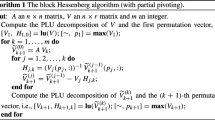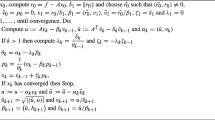Abstract
The Generalized Minimal Residual (GMRES) method and the Quasi-Minimal Residual (QMR) method are two Krylov methods for solving linear systems. The main difference between these methods is the generation of the basis vectors for the Krylov subspace. The GMRES method uses the Arnoldi process while QMR uses the Lanczos algorithm for constructing a basis of the Krylov subspace.
In this paper we give a new method similar to QMR but based on the Hessenberg process instead of the Lanczos process. We call the new method the CMRH method. The CMRH method is less expensive and requires slightly less storage than GMRES. Numerical experiments suggest that it has behaviour similar to GMRES.
Similar content being viewed by others
References
O. Axelsson, Conjugate gradient type methods for unsymmetric and inconsistent systems of linear equations, Linear Algebra Appl. 29 (1980) 1–16.
Z. Bai, D. Hu and L. Reichel, A Newton basis GMRES implementation, IMA J. Numer. Anal. 14 (1994) 563–581.
A. Björck, Least squares methods, in: Handbook of Numerical Analysis, Vol. I: Finite Difference Methods – Solution of Equations in ℝ n, eds. P.G. Ciarlet and J.L. Lions (Elsevier/North-Holland, Amsterdam, 1990).
C. Brezinski, Other manifestations of the Schur complement, Linear Algebra Appl. 111 (1988) 231–247.
C. Brezinski, M. Redivo-Zaglia and H. Sadok, Avoiding breakdown and near breakdown in Lanczos type algorithms, Numer. Algorithms 1 (1991) 199–206.
C. Brezinski, M. Redivo-Zaglia and H. Sadok, A breakdown-free Lanczos type algorithm for solving linear systems, Numer. Math. 45 (1992) 361–376.
P.N. Brown, A theoretical comparison of the Arnoldi and the GMRES algorithms, SIAM J. Sci. Statist. Comput. 12 (1991) 58–78.
S.C. Eisenstat, H.C. Elman and M.H. Schultz, Variational iterative methods for nonsymmetric systems of linear equations, SIAM J. Numer. Anal. 20 (1983) 345–357.
H.C. Elman, Iterative methods for large sparse nonsymmetric systems of linear equations, Ph.D. thesis, Computer Science Dept., Yale University, New Haven, CT (1982).
R. Freund, On Conjugate Gradient type methods and polynomial preconditioners for a class of complex non-Hermitian matrices, Numer. Math. 57 (1990) 285–312.
R. Freund, G.H. Golub and N.M. Nachtigal, Iterative solution of linear systems, Acta Numerica 1 (1992) 57–100.
R. Freund, M.H. Gutknecht and N.M. Nachtigal, An implementation of the look-ahead Lanczos algorithm for non-Hermitian matrices, SIAM J. Sci. Statist. Comput. 14 (1993) 137–158.
R. Freund and N.M. Nachtigal, QMR: A quasi-minimal residual method for non-Hermitian linear systems, Numer. Math. 60 (1991) 315–339.
R. Freund and N.M. Nachtigal, An implementation of the QMR method based on coupled two-term recurrences, SIAM J. Sci. Statist. Comput. 15 (1994) 313–337.
G. Golub and C.F. van Loan, Matrix Computations, 2nd ed. (Johns Hopkins Univ. Press, Baltimore, MD, 1989).
R.T. Gregory and D.L. Karney, A Collection of Matrices for Testing Computational Algorithms (Wiley, New York, 1969).
M.H. Gutknecht, A completed theory of the unsymmetric Lanczos process and related algorithms Part I, SIAM J. Matrix Anal. Appl. 13 (1992) 594–639.
K. Hessenberg, Behandlung der linearen Eigenwert-Aufgaben mit Hilfe der Hamilton–Cayleychen Gleichung, Darmstadt dissertation (1940).
A.S. Householder, The Theory of Matrices in Numerical Analysis (Dover, New York, 1974).
Y. Huang and H.A. van der Vorst, Some observations on the convergence behaviour of GMRES, Delft University of Technology, Report 89-09 (1989).
W.D. Joubert, Lanczos methods for the solution of nonsymmetric systems of linear equations, SIAM J. Matrix Anal. Appl. 13 (1992) 926–943.
W.D. Joubert and G.F. Carey, Parallelizable restarted iterative methods for nonsymmetric linear systems, Internat. J. Comput. Math. 44 (1992) 243–267.
B.N. Parlett, D.R. Taylor and Z.A. Liu, A look-ahead Lanczos algorithm for unsymmetric matrices, Math. Comp. 44 (1985) 105–124.
Y. Saad, Krylov subspace methods for solving large unsymmetric linear systems, Math. Comp. 37 (1981) 105–126.
Y. Saad and M.H. Schultz, GMRES: a generalized minimal residual algorithm for solving nonsymmetric linear systems, SIAM J. Sci. Statist. Comput. 7 (1986) 856–869.
K. Turner and H.F. Walker, Efficient hight accuracy solutions with GMRES(m), SIAM J. Sci. Statist. Comput. 13 (1992) 815–825.
H.A. van der Vorst, The convergence behaviour of some iterative solution methods, Delft University of Technology, Report 89-19 (1989).
H.A. van der Vorst and C. Vuik, The superlinear convergence of GMRES, J. Comput. Appl. Math. 48 (1993) 327–341.
C. Vuik and H.A. van der Vorst, A comparison of some GMRES-like methods, Linear Algebra Appl. 160 (1992) 131–162.
H.F. Walker, Implementation of the GMRES method using Householder transformations, SIAM J. Sci. Statist. Comput. 9 (1988) 152–163.
H.F. Walker and L. Zhou, A simpler GMRES, Utah State University, Report 1/92/54 (1992).
J.H. Wilkinson, The Algebraic Eigenvalue Problem (Clarendon Press, Oxford, UK, 1965).
D.M. Young and K.C. Jea, Generalized conjugate gradient acceleration of nonsymmetrizable iterative methods, Linear Algebra Appl. 34 (1980) 159–194.
Author information
Authors and Affiliations
Rights and permissions
About this article
Cite this article
Sadok, H. CMRH: A new method for solving nonsymmetric linear systems based on the Hessenberg reduction algorithm. Numerical Algorithms 20, 303–321 (1999). https://doi.org/10.1023/A:1019164119887
Issue Date:
DOI: https://doi.org/10.1023/A:1019164119887




